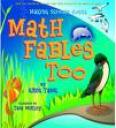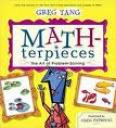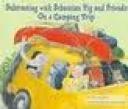An important part of first grade math is learning addition and subtraction facts. Students need to develop an understanding of the relationship between addition and subtraction as well as develop strategies for quick recall of facts. This post includes some of the best resources for helping students learn addition and subtraction facts to 18.
Books
Math Fables Too
by Greg Tang
Illustrated by Taia Morley
This book is math and science all in one. Students will learn interesting facts about the behavior of animals such as bats, archerfish, and seagulls, they will develop their vocabulary and learn addition facts. Students are presented with a number of animals grouped in different ways. For instance 4 herons are all together, then 3 use a feather and 1 uses a twig to lure fish to the surface of the water. There are many excellent teaching opportunities in this book.
Math-terpieces
by Greg Tang
Illustrated by Greg Paprocki
In this book math is combined with art history. Each page focuses on a famous work of art by artists such as Degas, Warhol, and Pollock. Each page has groupings of objects related to the painting. Students are asked to add together the groups to get a certain sum. Students also get the opportunity to see how three or more groups can be used to get the desired sum. Tang tells students how many ways it is possible to get the sum and provides all the illustrated answers in the back of the book.
Mission: Addition
written and illustrated by Loreen Leedy
This is a very well illustrated and engaging book with stories that students will love. Leedy includes all the basic concepts of addition including definitions, place value, horizontal and vertical computation, adding groups of the same things and groups of different things, as well as incorporating word/story problems throughout.
Subtraction Action
written and illustrated by Loreen Leedy
The same characters from Mission: Addition appear in Leedy’s subtraction book. This is a great book for teaching the concept of subtraction. Leedy covers all the basics of subtraction including definitions and showing each step of a subtraction problem. She uses numbers, words, and pictures to tell subtraction stories.
Subtracting with Sebastian Pig and Friends On a Camping Trip
by Jill Anderson
illustrated by Amy Huntington
In this book some of the things that Sebastian and his friends need on their camping trip are disappearing. Each page spread tells of a missing item. “Where Are the Worms? There were seven worms. Now there is just one! How many worms are missing?” Each problem in the story is represented in the text by a word problem and also in Sebastian’s notebook where he writes the number sentence, draws a picture representation of the problem and then lists the addition facts from that family. Students who pay attention will see that it’s a group of mice who are taking the campers things.
Websites for Students
Addition Word Problems is a great activity for students to get experience solving story problems. If a student enters an incorrect answer they can click on the button “Explanation” and they will see a written explanation of the problem, a strategy for solving, and the number sentence for the correct answer. When they are finished playing they will get a summary of their time and how many problems they solved correctly.
Alien Addition is an arcade style game where students must use the arrow keys to move back and forth firing the laser “sum” at the spaceship with the corresponding number sentence. Students may select the range for facts as well as the speed of the game. At the end of each stage students get a summary of hits and misses (incorrect answers). Misses show the student’s answer and the correct number sentence. Minus Mission is the subtraction version of Alien Addition.
Sum Sense is a subtraction game that challenges students by giving them three number cards that they must arrange into the correct number sentence. They can choose the number of problems they want and a time from one to ten minutes to solve. If the student answers incorrectly they are told to try again.
Hidden Pictures can be played with either addition or subtraction facts. Students solve problems to uncover a photograph. The photos are of animals in their natural habitats and a short description is given for each one. Addition Concentration is also a fun game on this website.
Funbrain includes several games that are great for practicing addition and subtraction facts. Line Jumper gives students the visual of a number line for solving addition and subtraction problems between 1-20. Students can play Tic Tac Toe against the computer with addition or subtraction facts. In Math Baseball students solve addition or subtraction problems to move around the bases and score runs. A one or two player version is available.
Additional Resources for Teachers
Mathwire.com is a great source for addition and subtraction classroom games and templates you can use for assessment or as center activities. The site also includes good ideas and resources for incorporating writing in math.
The NCTM Illuminations site has a large collection of lesson plans for teaching addition and subtraction. Each lesson in the list is actually a unit plan that contains up to five related lessons.
UEN.org provides a great resource for games and centers that will help students practice their addition and subtraction facts. Templates in pdf form are included for all the games as well as background information, instructional procedures, assessment plans, and extension ideas.
There are some good short video clips on addition and subtraction that you could incorporate into lessons or use at listening stations. Many use music and interesting visuals and could be helpful for students who are having difficulty remembering certain facts. Here are a few good videos that I have found: Adding and Subtracting Song, Adding 9 + 1, Doubles Doubles, and Five Bees, which also counts in Spanish.





